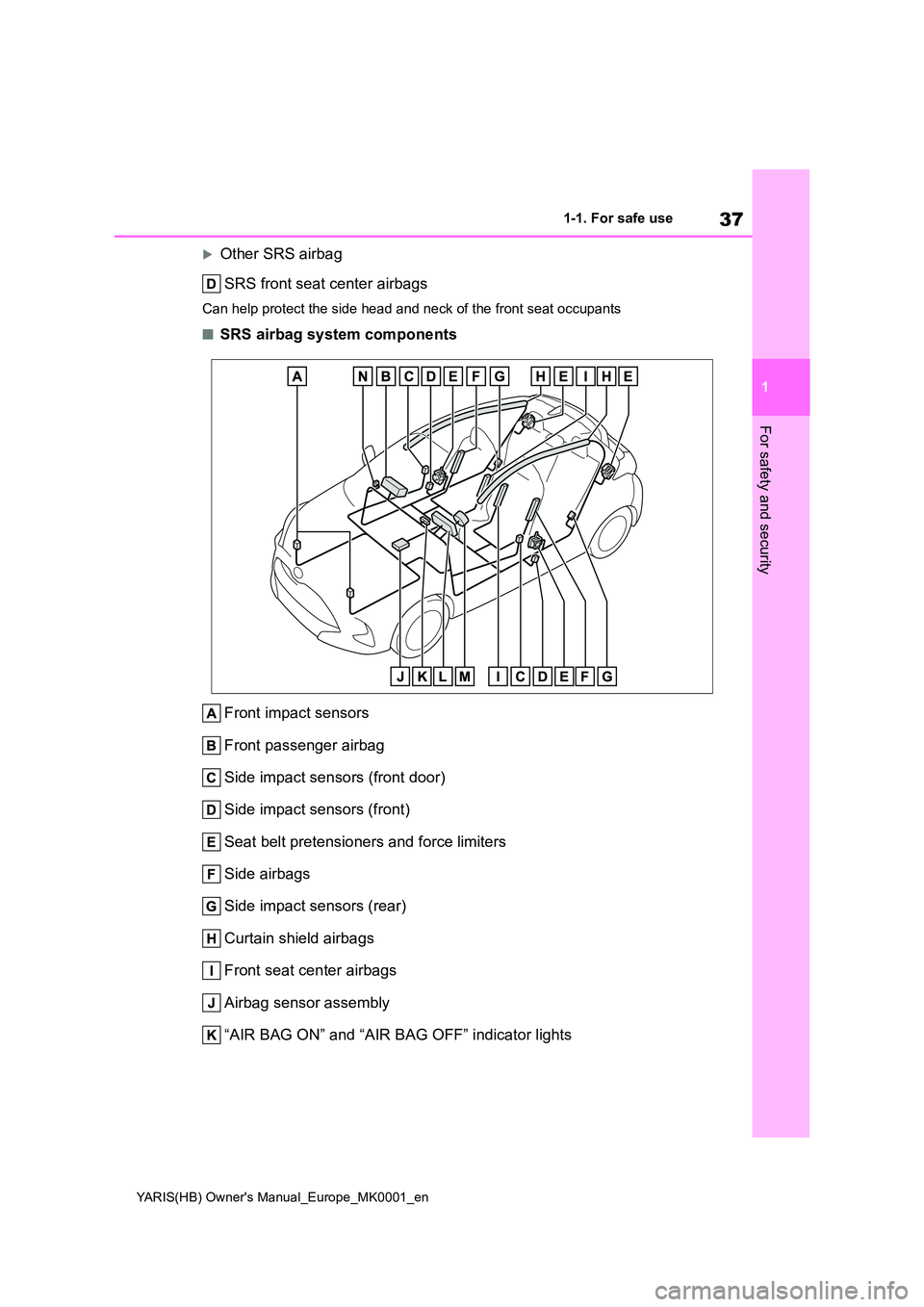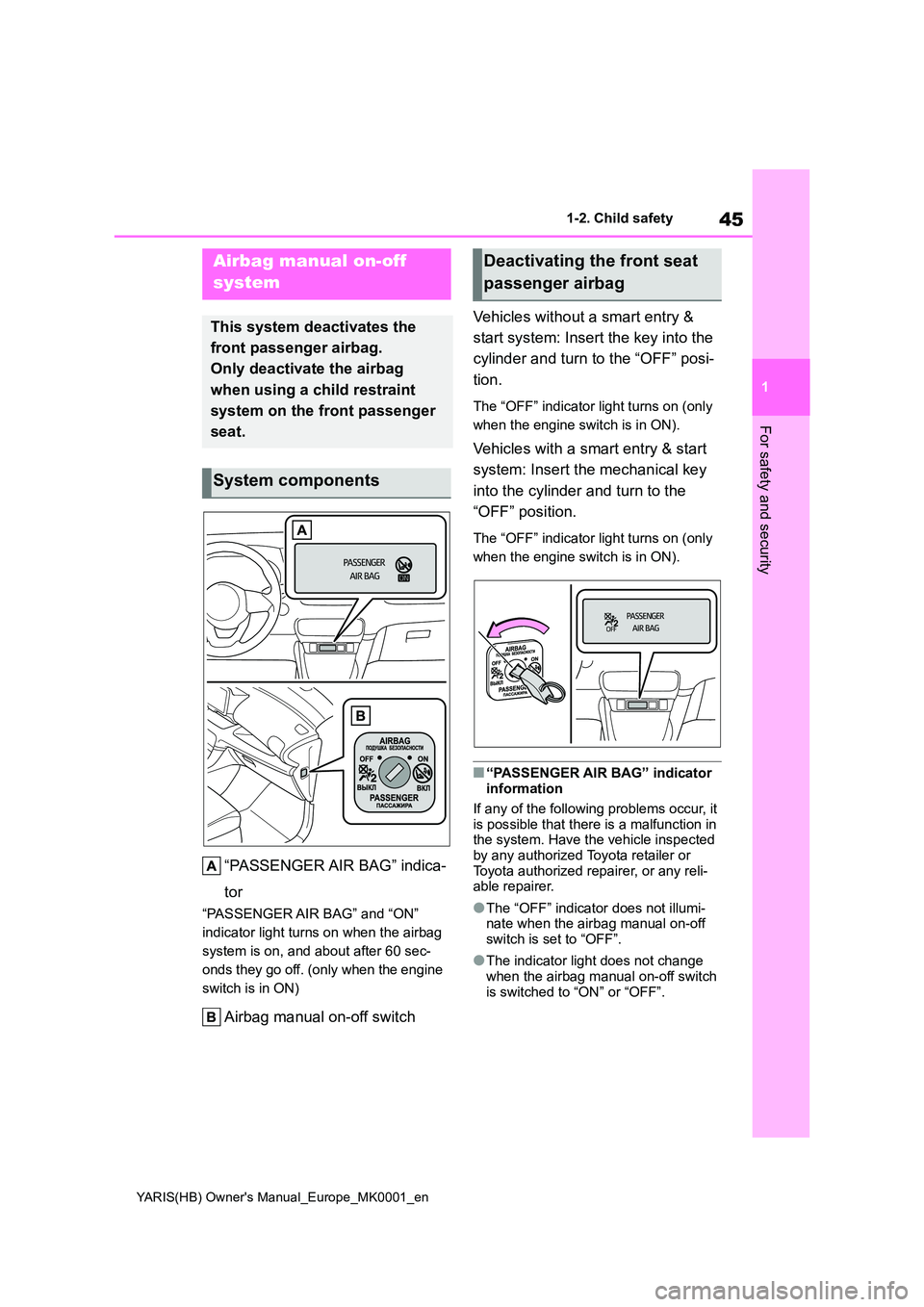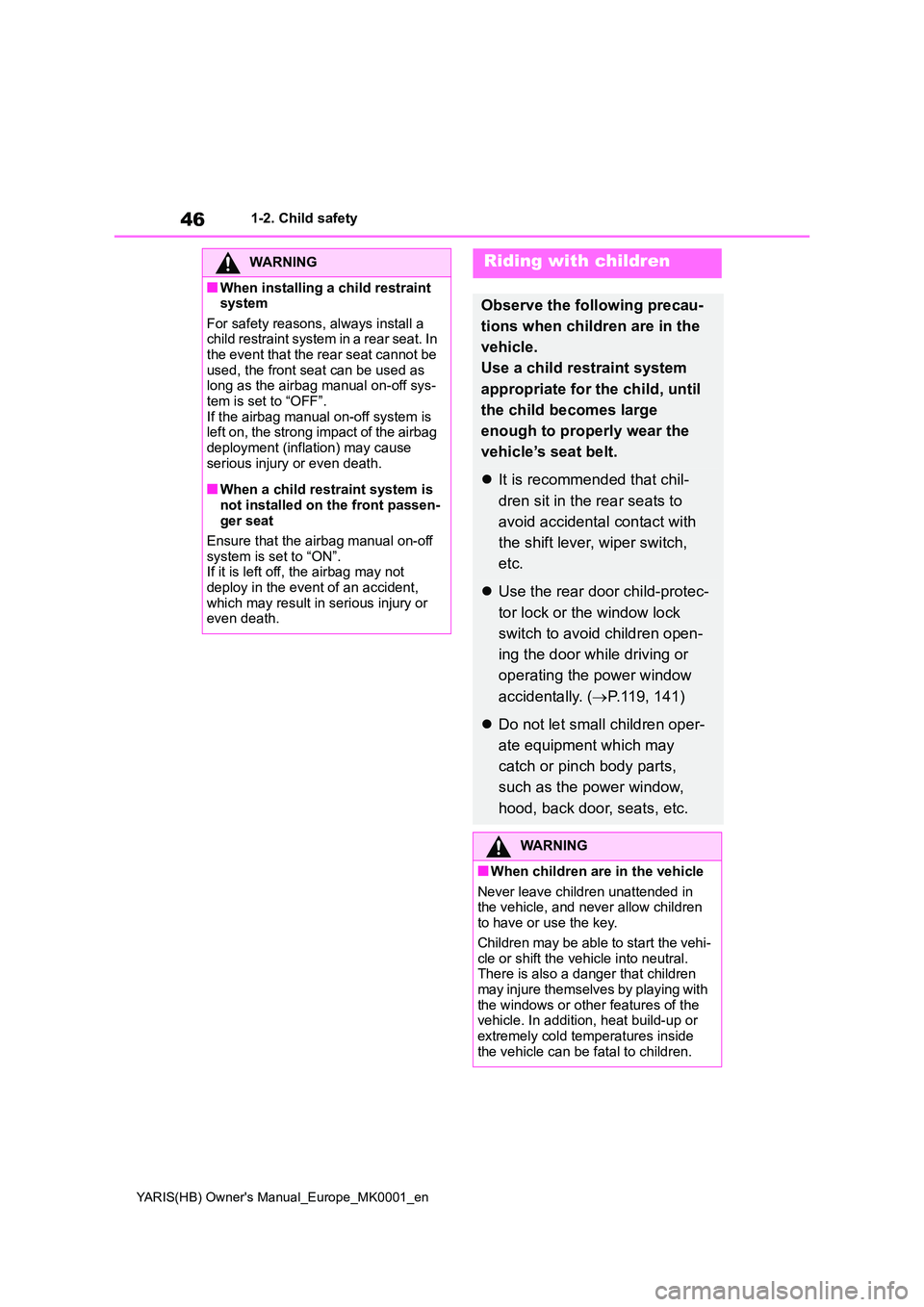2021 TOYOTA YARIS HATCHBACK airbag off
[x] Cancel search: airbag offPage 2 of 568

2
YARIS(HB) Owner's Manual_Europe_MK0001_en
TABLE OF CONTENTS
For your information ........................6
Reading this manual........................ 9
How to search ............................... 10
Pictorial index ................................ 12
1-1. For safe use
Before driving........................ 30
For safe driving ..................... 31
Seat belts .............................. 33
SRS airbags.......................... 36
Exhaust gas precautions ...... 44
1-2. Child safety
Airbag manual on-off system 45
Riding with children............... 46
Child restraint systems ......... 47
1-3. Emergency assistance
eCall...................................... 66
1-4. Theft deterrent system
Engine immobilizer system ... 76
Double locking system .......... 77
Alarm .................................... 78
2-1. Instrument cluster
Warning lights and indicators 82
Gauges and meters (vertical dis-
play) .................................... 86
Gauges and meters (horizontal
display) ............................... 90
Multi-information display (verti-
cal display).......................... 93
Multi-information display (hori-
zontal display)..................... 99
Head-up display .................. 105
Fuel consumption information
.......................................... 109
3-1. Key information
Keys .................................... 112
3-2. Opening, closing and locking
the doors
Side doors........................... 116
Back door............................ 120
Smart entry & start system . 123
3-3. Adjusting the seats
Front seats .......................... 128
Rear seats .......................... 129
Head restraints ................... 130
3-4. Adjusting the steering wheel
and mirrors
Steering wheel .................... 134
Inside rear view mirror ........ 135
Outside rear view mirrors.... 136
1For safety and security
2Vehicle status information
and indicators
3Before driving
Page 7 of 568

7
YARIS(HB) Owner's Manual_Europe_MK0001_en
sures or special instructions regard-
ing installation of an RF-transmitter
system.
Further information regarding fre-
quency bands, power levels,
antenna positions and installation
provisions for the installation of RF-
transmitters, is available on request
at any authorized Toyota retailer or
Toyota authorized repairer, or any
reliable repairer.
The vehicle is equipped with
sophisticated computers that will
record certain data, such as:
• Engine speed/Electric motor
speed (traction motor speed)
• Accelerator status
• Brake status
• Vehicle speed
• Operation status of the driving
assist systems
• Images from the cameras
Your vehicle is equipped with cameras.
Contact any authorized Toyota retailer
or Toyota authorized repairer, or any
reliable repairer for the location of
recording cameras.
The recorded data varies according
to the vehicle grade level and
options with which it is equipped.
These computers do not record
conversations or sounds, and only
record images outside of the vehi-
cle in certain situations.
�zData usage
Toyota may use the data recorded in this computer to diagnose malfunc-
tions, conduct research and develop-
ment, and improve quality.
Toyota will not disclose the recorded
data to a third party except:
• With the consent of the vehicle owner
or with the consent of the lessee if
the vehicle is leased
• In response to an official request by
the police, a court of law or a govern-
ment agency
• For use by Toyota in a lawsuit
• For research purposes where the
data is not tied to a specific vehicle or
vehicle owner
�zRecorded image information can
be erased by any authorized
Toyota retailer or Toyota autho-
rized repairer, or any reliable
repairer.
The image recording function can be
disabled. However, if the function is dis-
abled, data from when the system oper-
ates will not be available.
The SRS airbag and seat belt
pretensioner devices in your Toyota
contain explosive chemicals. If the
vehicle is scrapped with the airbags
and seat belt pretensioners left as
they are, this may cause an acci-
dent such as fire. Be sure to have
the systems of the SRS airbag and
seat belt pretensioner removed and
disposed of by a qualified service
shop or by any authorized Toyota
retailer or Toyota authorized
repairer, or any reliable repairer
before you scrap your vehicle.
Vehicle data recording
Scrapping of your Toyota
Page 29 of 568

1
29
YARIS(HB) Owner's Manual_Europe_MK0001_en
1
For safety and security
For safety and security
1-1. For safe use
Before driving ..................... 30
For safe driving ................... 31
Seat belts............................ 33
SRS airbags ....................... 36
Exhaust gas precautions .... 44
1-2. Child safety
Airbag manual on-off system
......................................... 45
Riding with children ............ 46
Child restraint systems ....... 47
1-3. Emergency assistance
eCall ................................... 66
1-4. Theft deterrent system
Engine immobilizer system . 76
Double locking system........ 77
Alarm .................................. 78
Page 37 of 568

37
1
YARIS(HB) Owner's Manual_Europe_MK0001_en
1-1. For safe use
For safety and security
Other SRS airbag
SRS front seat center airbags
Can help protect the side head and neck of the front seat occupants
■SRS airbag system components
Front impact sensors
Front passenger airbag
Side impact sensors (front door)
Side impact sensors (front)
Seat belt pretensioners and force limiters
Side airbags
Side impact sensors (rear)
Curtain shield airbags
Front seat center airbags
Airbag sensor assembly
“AIR BAG ON” and “AIR BAG OFF” indicator lights
Page 38 of 568

38
YARIS(HB) Owner's Manual_Europe_MK0001_en
1-1. For safe use
SRS warning light
Driver airbag
Airbag manual on-off switch
The main SRS airbag system components are shown above. The SRS air-
bag system is controlled by the airbag sensor assembly. As the airbags
deploy, a chemical reaction in the inflators quickly fills the airbags with non-
toxic gas to help restrain the motion of the occupants.
■If the SRS airbags deploy (inflate)
●Slight abrasions, burns, bruising etc., may be sustained from SRS airbags, due to the extremely high speed
deployment (inflation) by hot gases.
●A loud noise and white powder will be emitted.
●Parts of the airbag module (steering wheel hub, airbag cover and inflator) as well as the front seats, parts of the
front and rear pillars, and roof side rails, may be hot for several minutes. The airbag itself may also be hot.
●The windshield may crack.
●The brakes and stop lights will be con-trolled automatically. ( →P.269)
●The interior lights will turn on automat- ically. ( →P.292)
●The emergency flashers will turn on automatically. ( →P.360)
●Fuel supply to the engine will be stopped. ( →P.367)
●Vehicles with eCall: If any of the fol-
lowing situations occur, the system is
designed to send an emergency call*
to the eCall control center, notifying them of the vehicle’s location (without needing to push the “SOS” button)
and an agent will attempt to speak with the occupants to ascertain the level of emergency and assistance
required. If the occupants are unable to communicate, the agent automati-cally treats the call as an emergency
and helps to dispatch the necessary emergency services. ( →P.66)
• An SRS airbag is deployed.
• A seat belt pretensioner is activated. • The vehicle is involved in a severe rear-end collision.*: In some cases, the call cannot be
made. ( →P. 6 7 )
■SRS airbag deployment conditions
(SRS front airbags)
●The SRS front airbags will deploy in
the event of an impact that exceeds the set threshold level (the level of force corresponding to an approxi-
mately 20 - 30 km/h [12 - 18 mph] frontal collision with a fixed wall that does not move or deform).
However, this threshold velocity will be considerably higher in the following situ-
ations: • If the vehicle strikes an object, such as a parked vehicle or sign pole,
which can move or deform on impact • If the vehicle is involved in an under-ride collision, such as a collision in
which the front of the vehicle “under- rides”, or goes under, the bed of a truck
●Depending on the type of collision, it is possible that only the seat belt
pretensioners will activate.
■SRS airbag deployment conditions (SRS side and curtain shield air-bags)
●The SRS side and curtain shield air-bags will deploy in the event of an
impact that exceeds the set threshold level (the level of force corresponding to the impact force produced by an
Page 43 of 568

43
1
YARIS(HB) Owner's Manual_Europe_MK0001_en
1-1. For safe use
For safety and security
WARNING
●Do not strike or apply significant levels of force to the area of the
SRS airbag components or the front doors.Doing so can cause the SRS air-
bags to malfunction.
●Do not touch any of the component
parts immediately after the SRS air- bags have deployed (inflated) as they may be hot.
●If breathing becomes difficult after the SRS airbags have deployed,
open a door or window to allow fresh air in, or leave the vehicle if it is safe to do so. Wash off any resi-
due as soon as possible to prevent skin irritation.
●If the areas where the SRS airbags are stored, such as the steering wheel pad and front and rear pillar
garnishes, are damaged or cracked, have them replaced by any authorized Toyota dealer or
repairer, or another duly qualified and equipped professional.
■Modification and disposal of SRS airbag system components
Do not dispose of your vehicle or per-
form any of the following modifica- tions without consulting your Toyota retailer or Toyota authorized repairer,
or any reliable repairer. The SRS air- bags may malfunction or deploy (inflate) accidentally, causing death or
serious injury.
●Installation, removal, disassembly
and repair of the SRS airbags
●Repairs, modifications, removal or
replacement of the steering wheel, instrument panel, dashboard, seats or seat upholstery, front, side and
rear pillars, roof side rails, front door panels, front door trims or front door speakers
●Modifications to the front door panel (such as making a hole in it)
●Repairs or modifications of the front fender, front bumper, or side of the occupant compartment
●Installation of a grille guard (bull bars, kangaroo bar, etc.), snow
plows or winches
●Modifications to the vehicle’s sus-
pension system
●Installation of electronic devices
such as mobile two-way radios (RF- transmitter) and CD players
Page 45 of 568

45
1
YARIS(HB) Owner's Manual_Europe_MK0001_en
1-2. Child safety
For safety and security
1-2.Child sa fety
“PASSENGER AIR BAG” indica-
tor
“PASSENGER AIR BAG” and “ON”
indicator light turns on when the airbag
system is on, and about after 60 sec-
onds they go off. (only when the engine
switch is in ON)
Airbag manual on-off switch
Vehicles without a smart entry &
start system: Insert the key into the
cylinder and turn to the “OFF” posi-
tion.
The “OFF” indicator light turns on (only
when the engine switch is in ON).
Vehicles with a smart entry & start
system: Insert the mechanical key
into the cylinder and turn to the
“OFF” position.
The “OFF” indicator light turns on (only
when the engine switch is in ON).
■“PASSENGER AIR BAG” indicator information
If any of the following problems occur, it
is possible that there is a malfunction in the system. Have the vehicle inspected by any authorized Toyota retailer or
Toyota authorized repairer, or any reli- able repairer.
●The “OFF” indicator does not illumi-nate when the airbag manual on-off switch is set to “OFF”.
●The indicator light does not change when the airbag manual on-off switch
is switched to “ON” or “OFF”.
Airbag manual on-off
system
This system deactivates the
front passenger airbag.
Only deactivate the airbag
when using a child restraint
system on the front passenger
seat.
System components
Deactivating the front seat
passenger airbag
Page 46 of 568

46
YARIS(HB) Owner's Manual_Europe_MK0001_en
1-2. Child safety
WARNING
■When installing a child restraint system
For safety reasons, always install a child restraint system in a rear seat. In the event that the rear seat cannot be
used, the front seat can be used as long as the airbag manual on-off sys-tem is set to “OFF”.
If the airbag manual on-off system is left on, the strong impact of the airbag deployment (inflation) may cause
serious injury or even death.
■When a child restraint system is
not installed on the front passen- ger seat
Ensure that the airbag manual on-off
system is set to “ON”. If it is left off, the airbag may not deploy in the event of an accident,
which may result in serious injury or even death.
Riding with children
Observe the following precau-
tions when children are in the
vehicle.
Use a child restraint system
appropriate for the child, until
the child becomes large
enough to properly wear the
vehicle’s seat belt.
�z It is recommended that chil-
dren sit in the rear seats to
avoid accidental contact with
the shift lever, wiper switch,
etc.
�z Use the rear door child-protec-
tor lock or the window lock
switch to avoid children open-
ing the door while driving or
operating the power window
accidentally. ( →P.119, 141)
�zDo not let small children oper-
ate equipment which may
catch or pinch body parts,
such as the power window,
hood, back door, seats, etc.
WARNING
■When children are in the vehicle
Never leave children unattended in the vehicle, and never allow children to have or use the key.
Children may be able to start the vehi- cle or shift the vehicle into neutral. There is also a danger that children
may injure themselves by playing with the windows or other features of the vehicle. In addition, heat build-up or
extremely cold temperatures inside the vehicle can be fatal to children.